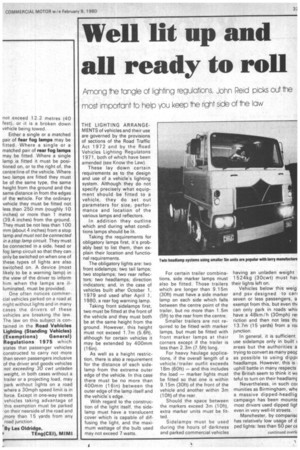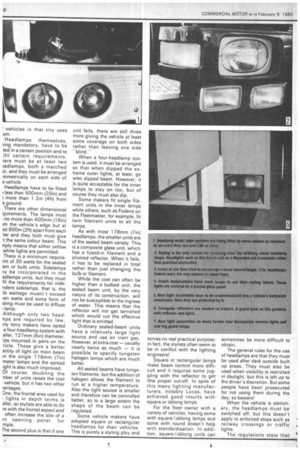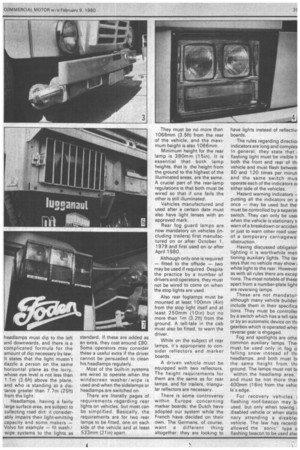Well lit up and all ready to roll
Page 39

Page 40

Page 41

If you've noticed an error in this article please click here to report it so we can fix it.
Among the tangle of lighting regulations, John Reid picks CT most mooant to help you keep ne right side of e law
THE LIGHTING ARRANGEMENTS of vehicles and their use are governed by the provisions of sections of the Road Traffic Act 1972 and by the Road Vehicles Lighting Regulatons 1971, both of which have been amended (see Know the Law).
These lay down certain requirements as to the design and use of a vehicle's lighting system. Although they do not specify precisely what equipment should be fitted to a vehicle, they do set out parameters for size, performance and location of the various lamps and reflectors.
In addition they outline which and during what conditions lamps should be lit.
Taking the requirements for obligatory lamps first, ifs probably best to list them, then explain their location and functional requirements.
The obligatory lights are: two front sidelamps; two tail lamps; two stoplarnps; two rear reflectors: two headlamps; direction indicators; and, in the case of vehicles built after October 1, 1979 and used after April 1, 1980, a rear fog warning lamp.
Taking front sidelamps first, two must be fitted at the front of the vehicle and they must both be at the same height from the ground. However, this height must not exceed 1.7m (5.6ft), although for certain vehicles it may be extended by 400mm (16in).
As well as a height restriction, there is also a requirement for the distance of each side lamp from the extreme outer edge of the vehicle. In this case there must be no more than 400mm (16in) between the outer edge of the lamp itself and the vehicle's edge.
With regard to the construction of the light itself, the side lamp must have a translucent cover which is capable of diffusing the light, and the maximum wattage of the bulb used may not exceed 7 watts. For certain trailer combinations, side marker lamps must also be fitted. Those trailers which are longer than 9.15m (30ft) must have a side marker lamp on each side which falls between the centre point of the trailer, but no more than 1.5m (51t) to the rear from the centre.
Smaller trailers are not required to be fitted with marker lamps, but must be fitted with front marker lamps at their corners except if the trailer is less than 2.3m (7.5ft) long.
For heavy haulage applications, if the overall length of a vehicle /trailer outfit exceeds 18m (60ft) — and this includes the load — marker lights must be fitted so that one is within 9.15m (30ft) of the front of the vehicle and another within 3m (1 Oft) of the rear.
Should the space between the markers exceed 3m (10ft), extra marker units must be fitted.
Sidelamps must be used during the hours of darkness and parked commercial vehicles having an unladen weight • 1524kg (30cwt) must ha \ their lights left on.
Vehicles below this weig and psv designed • to can seven or less passengers, a exempt from this, but even thi can only park in roads whi( have a 48km /h (30mph) re: riction and then not less tf-1 13.7m (15 yards) from a rok' junction.
In general, it is sufficient use sidelamps only in built areas but the authorities a trying to convert as many peor as possible to using dippi headlamps. However, this is ; uphill battle in many respects the British seem to think it wz teful to turn on their head lamr Nevertheless, in such col munities as Birmingham, whe a massive dipped-headlig campaign has been mounte most drivers used dipped ligf even in very well-lit streets.
Manchester, by comparisc has relatively low usage of d ped lights: less than 50 per CE
vehicles in that city uses em.
Headlamps themselves, ,ing mandatory, have to be ted in a certain position and to Ifil certain requirements. .iere must be at least two )adlamps, both a matched lir, and they must be arranged mmetrically on each side of e vehicle.
Headlamps have to be fitted less than 500mm (20in) and more than 1.2m (4ft) from e ground.
There are other dimensional quirements. The lamps must no more than 400mm (16in) im the vehicle's edge but at
ist 600m (21t) apart from each ler and they both must give t the same colour beam. This nply means that either yellow white lights are permitted. There is a minimum require3nt of 30 watts for the sealed am or bulb units. Sidelamps 3y be incorporated in the adlamps units, but they must fil the requirements for indendent sidelamps, that is, the lb wattage mustn't exceed (en watts and some form of sting must be used to diffuse lamp.
Although only two headnps are required by law, iny lorry makers have opted a four-headlamp system with eller, 127mm (5in) diameter, -ips mounted in pairs on the These give a better 3ntity of light on main beam in the single 178mm (7in) meter lamps and the spread ight is also much improved. Of course, doubling the -nber of units raises the cost vehicle, but it has two other rantages.
Dne, the frontal area used for lights in depth terms is 311er, so stylists are able to do
re with the frontal aspect and often increase the size of a nt opening panel, for mole.
rhe second plus is that if one
unit fails, there are still three more giving the vehicle at least some coverage on both sides rather than leaving one side "blind.
When a four-headlamp system is used, it must be arranged so that when dipped the extreme outer lights, at least, go onto dipped beam. However, it is quite acceptable for the inner lamps to stay on too, but of course they must also dip.
Some makers fit single filament units in the inner lamps while others, such as Fodens on the Fleetmaster, for example, fit twin filament units to all the lamps.
As with most 178mm (7 in) headlamps, the smaller units are of the sealed beam variety. This is a composite glass unit, which has a fused-in filament and a silvered reflector. When it fails, it has to be replaced in total rather than just changing the bulb or filament.
While the cost can often be higher than a bulbed unit, the sealed beam unit, by the very nature of its construction, will not be susceptible to the ingress of water. This means that the reflector will not get tarnished which would cut the effective light that is emitted.
Ordinary sealed-beam units have a relatively large light source and use an inert gas.
However, at extra cost — usually nearly twice as much — it is possible to specify tungsten halogen lamps which are much better.
All sealed beams have tungsten filaments, but the addition of halogen allows the filament to run at a higher temperature. Also the light source is smaller and therefore can be controlled better, so to a large extent the shape of the beam can be regulated.
Some vehicle makers have adopted square or rectangular headlamps for their vehicles. This is purely a styling ploy and serves no real practical purpose; in fact, the stylists often seem to be in conflict with the lighting engineers!
Square or rectangular lamps make beam control more difficult and it requires some juggling with the reflector to get tthe proper cut-off. In spite of this many lighting manufacturers, notably Lucas, have achieved good results with square or oblong lamps.
For the fleet owner with a variety of vehicles, having some with square/oblong lamps and some with round doesn't help with standardisation. In addition, square/oblong units can sometimes obtain.
The general rules for the use of headlamps are that they must be used after dark outside built up areas. They must also be used when visibility is restricted in daylight, but this is left up to the driver's discretion. But some people have been prosecuted for not using them during the day, so beware!
When the vehicle is stationary, the headlamps must be switched off, but this doesn't apply to enforced stops such as railway crossings or traffic lights.
The regulations state that
headlamps must dip to the left and downwards, and there is a complicated formula for the amount of dip necessary by law. It states that the light mustn't dazzle a person on the same horizontal plane as the lorry, whose eye level is not less than 1.1m (3.6ft) above the plane, and who is standing at a distance greater than 7.7m (25ft) from the light.
Headlamps, having a fairly large surface area, are subject to collecting road dirt: it considerably impairs their light-emitting capacity and some makers — Volvo for example — fit wash/ wipe systems to the lights as standard. If these are added as an extra, they cost around £80. Some operators may consider these a useful extra if the driver cannot be persuaded to clean his headlamps regularly.
Most of the built-in systems are wired to operate when the windscreen washer/wipe is used and when the sidelamps or headlamps are switched on.
There are literally pages of requirements regarding rear lights on vehicles, but most can be simplified. Basically, the requirements are for two rear lamps to be fitted, one on each side of the vehicle and at least 533mm (21in) apart. They must be no more than 1066mm (3.5ft) from the rear of the vehicle, and the maximum height is also 1066mm.
Minimum height for the rear lamp is 380mm (1 bin). It is essential that both lamp heights, that is the height from the ground to the highest of the illuminated areas, are the same. A crucial part of the rear-lamp regulations is that both must be wired so that if one fails the other is still illuminated.
Vehicles manufactured and used after a certain date must also have light lenses with an approved mark.
Rear fog guard lamps are now mandatory on vehicles (including trailers) first manufactured on or after October 1, 1979 and first used on or after April 1980..
Although only one is required' — fitted to the offside — two may be used if required. Despite the practice by a number of drivers and operators, they must not be wired to come on when the stop lights are used.
Also rear foglamps must be mounted at least 100mm (4in) from the stop light itself and at least 250mm (10in) but no more than 1m (3.2ft) from the ground. A tell-tale in the cab must also be fitted, to warn the driver.
While on the subject of rear lamps, it's appropriate to consider reflectors and marker boards.
A driven vehicle must be equipped with two reflectors. The height requirements for them are the same as for rear lamps, and for trailers, triangular reflectors are necessary.
There is some controversy within Europe concerning marker boards: the Dutch have adopted our system while the French have decided on their own. The Germans, of course, want a different thing altogether: they are looking to have lights instead of reflectiv, boards.
The rules regarding directioi indicators are long and complex In general, they state that ; flashing light must be visible ti both the front and rear of thi vehicle and must flash betweei 60 and 120 times per minuti and the same switch mus operate each of the indicators oi either side of the vehicles.
Hazard warning indicators putting all the indicators on a once — may be used but the' must be controlled by a separati switch. They can only be use when the vehicle is stationary t( warn of a breakdown or acciden or just to warn other road user of a temporary carriagewa, obstruction.
Having discussed obligator, lighting it is worthwhile men tioning auxiliary lights. The lay says that no vehicle may show white light to the rear. However as with all rules there are excep tions. The most notable of these apart from a number-plate light are reversing lamps.
These are not mandator, although many vehicle builden include them in their specifica tions. They must be controllec by a switch which has a tell-tale or by an automatic device on thi gearbox which is operated wher reverse gear is engaged.
Fog and spotlights are othe common auxiliary lamps. The must be used only in fog o falling snow instead of thE headlamps, and both must bE the same height from thi ground. The lamps must not bE 'within the headlamp area,' and must be not more thar 400mm (16in) from the vehic le's edge.
For recovery vehicles ; flashing roof-beacon may bi used, but only when towing ; disabled vehicle or when static nary attending a disable(
vehicle. The law has recentl. allowed the -sonictype o flashing beacon to be used alsc




















































































































